The phenological stages of the grape are the different development phases that the vine goes through from the beginning of its growth until the fruit is harvested.
These phenological stages are essential for understanding the life cycle of the vine and for making appropriate viticultural decisions that optimize the quality and quantity of grape production.

The following describes these stages:
Bud Break (Budding)
Occurs in spring when temperatures start to rise. The winter buds begin to swell and eventually open, giving rise to green shoots.
Bud break, also known as budding or sprouting, is one of the most important stages in the vine’s life cycle. This process marks the beginning of the plant’s annual growth and is critical for the subsequent development of the harvest. The key aspects of bud break are described in detail here:
Bud Break Process
- Start of Biological Activity:
- Bud break begins when temperatures start to rise in spring, typically between March and April in the northern hemisphere. This temperature increase activates biological processes in the plant.
- Bud Swelling:
- The winter buds, which have been dormant during the winter, begin to swell. This swelling is one of the first visible signs of bud break.
- Bud Opening:
- The buds open and small green shoots begin to emerge. These shoots contain the first leaves and structures that will later develop into tendrils and clusters of flowers.

Factors Affecting Bud Break
- Temperature:
- Temperature is the main trigger for bud break. A sustained period of warm temperatures is necessary to initiate this process. Low temperatures can delay bud break, and late frosts can damage the tender shoots.
- Soil Moisture:
- The availability of water in the soil is also crucial. Well-hydrated soil facilitates the transport of nutrients and water to the buds, promoting their growth.
- Vine Condition:
- The overall health of the vine, including its nutrition and management during the previous season, affects the quality and vigor of the bud break. Well-maintained and properly pruned vines tend to break buds more uniformly and vigorously.
Importance of Bud Break
- Formation of the Harvest:
- Bud break is the first step in the development of the harvest. Strong and healthy shoots are essential for the growth of leaves and clusters of grapes, which will determine the quantity and quality of the harvest.
- Viticultural Management:
- Planning the Vegetative Cycle:
- Bud break marks the beginning of the vine’s vegetative cycle, and its synchronization with the climate and other environmental conditions is crucial for the success of the crop. An early or late bud break can affect all subsequent stages of vine development.
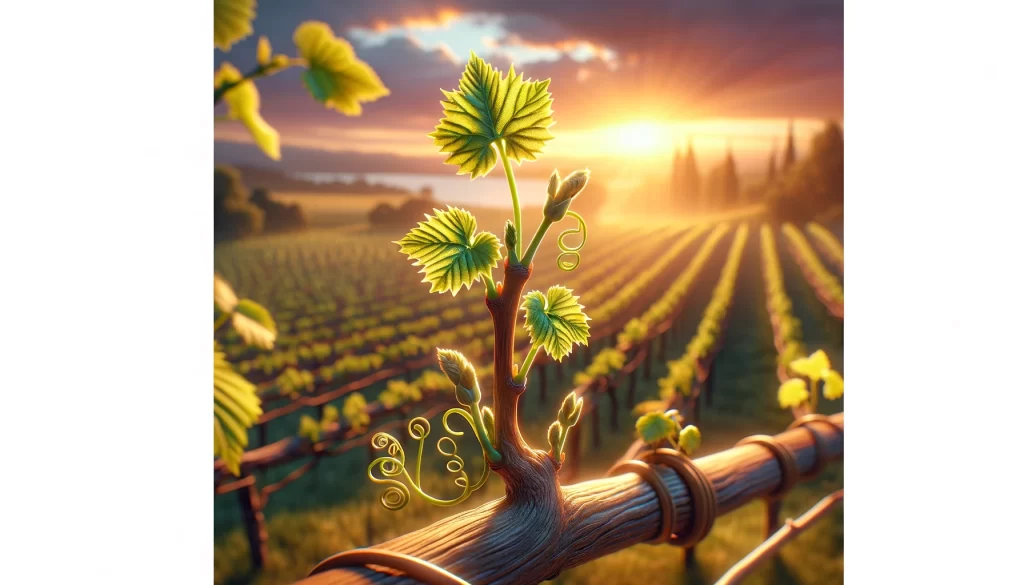
Risks and Challenges
- Late Frosts:
- Frosts after bud break can seriously damage young shoots, affecting the vine’s production for that season. Viticulturists often implement frost protection measures.
- Diseases:
- Tender shoots are susceptible to diseases such as downy mildew and powdery mildew. Constant monitoring and preventive treatments are essential to protect the plant.
Shoot Development
The shoots grow rapidly, developing leaves and tendrils. This phase is crucial for photosynthesis, which supplies the energy necessary for the plant’s growth.
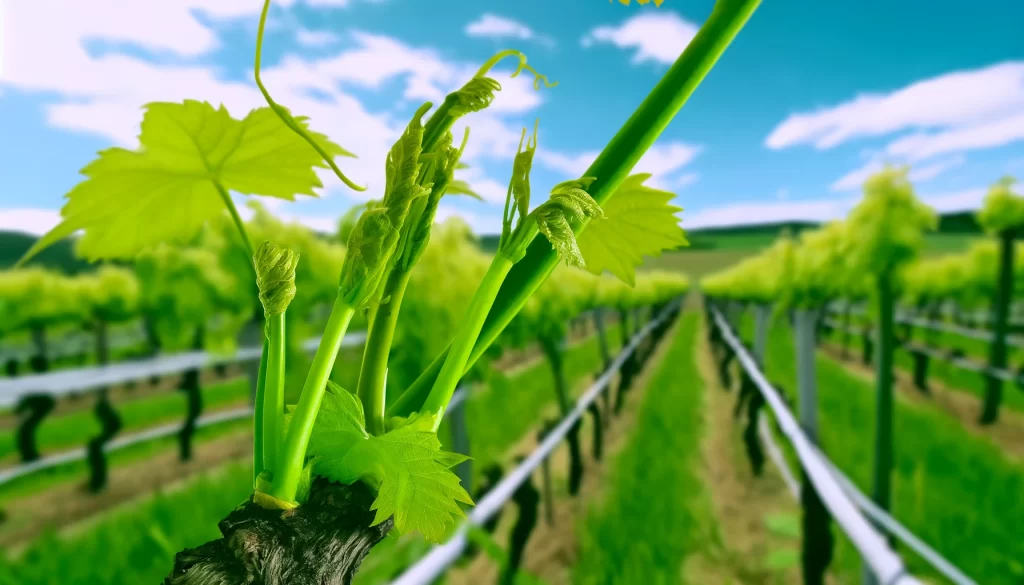
Shoot development is a crucial stage in the vine’s life cycle, following bud break and preparing the plant for flowering and fruiting. During this phase, the shoots grow rapidly, forming leaves and tendrils, which are essential for photosynthesis and plant support. The key aspects of shoot development are described in detail below:
Shoot Development Process
- Initial Growth:
- After bud break, the young shoots begin to elongate and develop leaves. This growth is rapid and significant elongation can be observed within a few days.
- Leaf Formation:
- As the shoots elongate, new leaves develop at the nodes of the shoots. The young leaves are initially small and tender but quickly grow and expand.
- Tendril Development:
- Tendrils, thread-like structures that the vine uses to climb and support itself, develop along with the leaves. These tendrils coil around supports such as trellis wires, providing stability to the plant.
Factors Affecting Shoot Development
- Temperature:
- Warm temperatures favor rapid shoot growth. Consistent and stable climate conditions are ideal for uniform development.
- Moisture and Irrigation:
- The availability of water is crucial. Well-hydrated soil facilitates nutrient uptake and maintains active shoot growth.
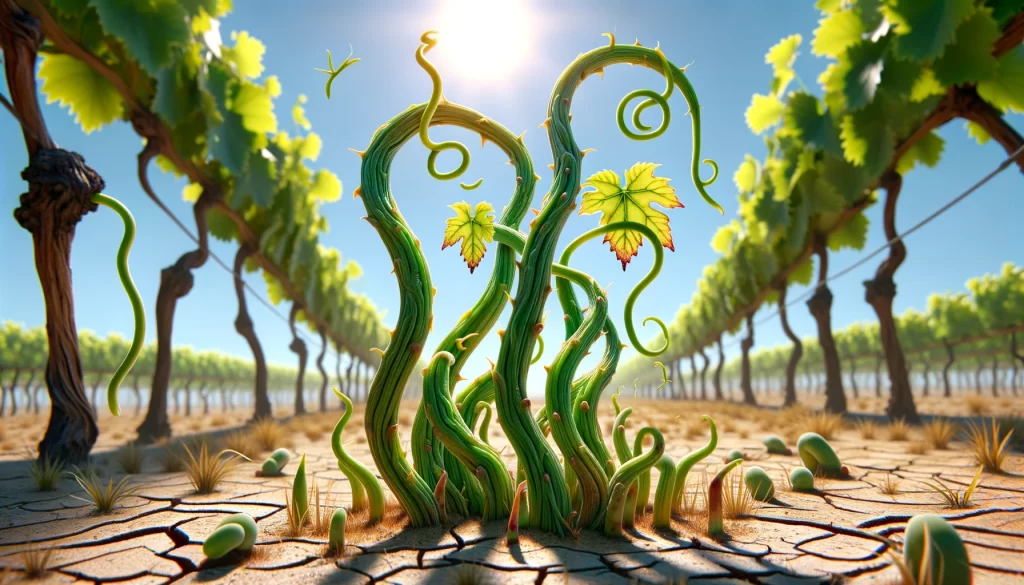
- Nutrients:
- Vine nutrition is fundamental. The availability of nutrients such as nitrogen, phosphorus, and potassium in the soil promotes healthy shoot growth.
- Sunlight:
- Adequate exposure to sunlight is essential for photosynthesis, which in turn fuels shoot growth and leaf formation.
Importance of Shoot Development
- Photosynthesis and Energy:
- The leaves developed during this stage are crucial for photosynthesis, the process by which the plant converts sunlight into energy. This energy is necessary for the growth and development of the entire plant.
- Preparation for Flowering:
- Vigorous shoot growth prepares the plant for flowering. Strong and well-developed shoots can support clusters of flowers and subsequently fruits.
- Canopy Formation:
- The canopy, or leaf cover, forms during this stage and is vital for fruit protection, temperature regulation, and optimizing photosynthesis.
Viticultural Management During Shoot Development
- Pruning and Training:
- During this phase, viticulturists can perform formative pruning to guide shoot growth and ensure proper plant structure.
- Pest and Disease Control:
- Young shoots are susceptible to pests and diseases. Preventive management and constant monitoring are essential to protect the plant.
- Support and Trellising:
- Trellising systems are fundamental for supporting growing shoots. Viticulturists must ensure that tendrils coil properly and that shoots are well-supported to prevent damage from wind or other factors.
Challenges and Common Problems
- Excessive Growth:
- Excessive shoot growth can lead to a dense canopy, which can hinder air circulation and increase susceptibility to diseases. Formative pruning and proper irrigation and fertilization management are essential to avoid this problem.
- Water Stress:
- Lack of water can slow down shoot growth and affect their development. It is important to maintain adequate irrigation, especially in dry climates.
- Nutrient Deficiencies:
- Nutrient deficiencies can manifest as weak growth and poor leaf development. A proper fertilization program is essential to ensure healthy growth.
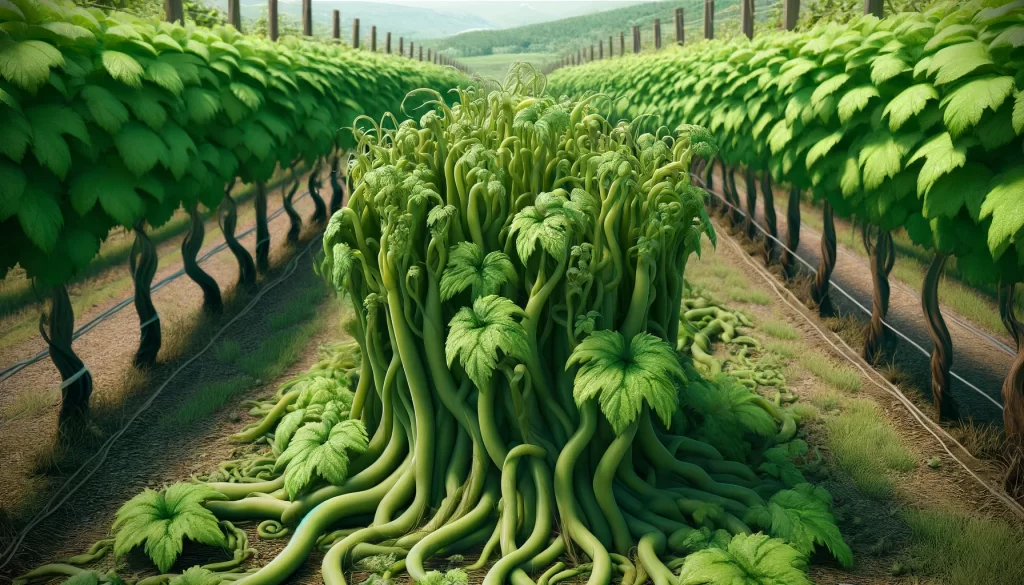
Shoot development is a critical stage that directly influences the overall health of the vine and the quality of the harvest. Careful management during this phase is essential to optimize production and ensure a successful harvest.
Flowering
It generally occurs between May and June in the northern hemisphere. Small, inconspicuous flowers open, and pollination can occur. It is a critical phase as it will determine the number of grapes that will form.

Flowering is a crucial stage in the vine’s life cycle, marking the beginning of grape cluster formation. During this phase, the vine’s flowers open, and pollination occurs, which will determine the success of fruit set and ultimately the quantity and quality of the harvest. The key aspects of flowering in grape cultivation are described in detail below:
Flowering Process
- Inflorescence Development:
- Inflorescences, or clusters of flowers, form on the young shoots. Each inflorescence contains numerous small, inconspicuous flowers.
- Flower Opening:
- Flowering generally occurs between May and June in the northern hemisphere. The vine’s flowers are perfect, meaning they contain both male (stamens) and female (pistils) organs.
- Pollination:
- Pollination in grapes is primarily autogamous, meaning most flowers self-pollinate. However, wind and, to a lesser extent, insects can aid in pollen transfer.
- Fertilization and Fruit Set:
- Once the flowers are pollinated, fertilization occurs, and small ovaries form, which will grow into grape berries. This process is known as fruit set.
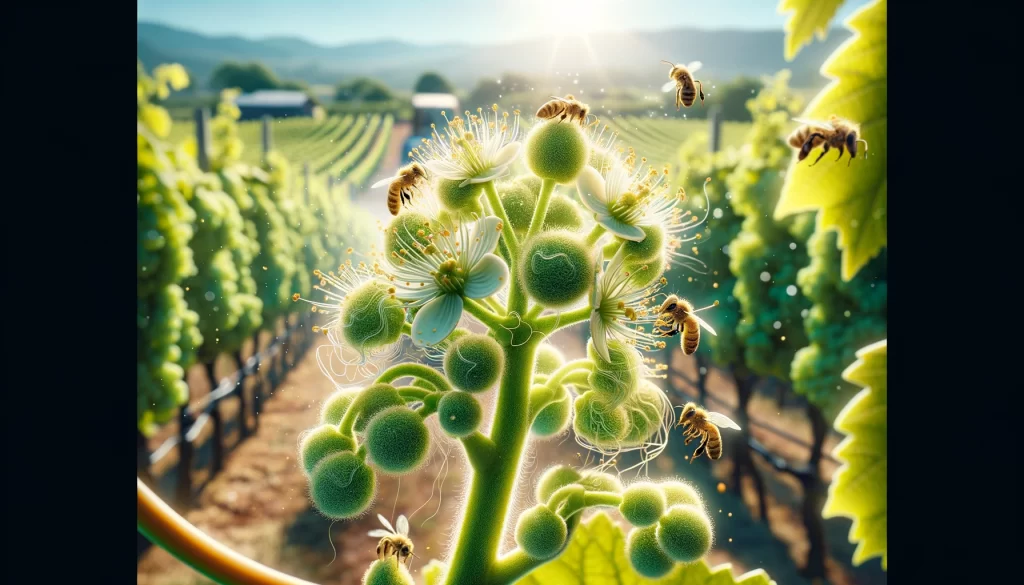
Factors Affecting Flowering
- Temperature:
- The ideal temperature for flowering is between 15 and 25 degrees Celsius. Extreme temperatures can negatively affect pollination and fruit set.
- Humidity:
- An adequate level of humidity is important for successful flowering. Excessive humidity can promote diseases, while a lack of humidity can affect flower opening and pollination.
- Wind:
- Wind can help in pollen dispersal. However, strong winds can damage flowers and reduce the fruit set rate.
- Vine Health:
- The overall nutrition and health of the vine affect flowering. Well-nourished and healthy vines will produce more vigorous inflorescences and more uniform flowering.
Importance of Flowering
- Determination of Harvest:
- Successful flowering is crucial for the quantity and quality of the harvest. Poor flowering can result in poor fruit set and low grape production.
- Viticultural Management:
- During flowering, viticulturists must pay attention to soil and climate conditions and make adjustments in vineyard management to ensure optimal flowering.
Management During Flowering
Irrigation and Fertilization:
Proper irrigation and fertilization are essential during flowering to ensure optimal vine nutrition and hydration.
Preventive Treatments:
Preventive treatments against diseases and pests are necessary to protect the flowers and young fruits.
Poor Fruit Set:
Poor fruit set can occur due to various factors such as extreme temperatures, high humidity, or strong winds. This problem results in fewer berries and lower production.
Pest and Disease Damage:
Flowers are susceptible to pests and diseases. Proper management and constant monitoring are essential to minimize damage during this stage.
Ovary Development:
After successful pollination and fertilization, the ovary of each flower begins to develop into a small berry.
Berry Growth:
During this initial stage, the berries are very small and green. They begin to grow in size and accumulate nutrients.
Cluster Formation:
The berries are grouped into clusters, each cluster containing multiple berries that develop from the flowers of a single inflorescence.
Temperature:
Optimal temperatures for fruit set are between 15 and 25 degrees Celsius. Extreme temperatures can lead to poor fruit set and berry drop.
Nutrient Availability:
Proper nutrition is crucial during fruit set. The availability of key nutrients such as nitrogen, phosphorus, and potassium in the soil influences the success of berry development.
Water Availability:
Adequate water supply is essential during fruit set. Water stress can lead to poor berry development and reduced yields.
Pollination Success:
The success of pollination during flowering directly affects fruit set. Poor pollination results in fewer berries and lower production.
Yield Determination:
The number of berries that successfully set determines the potential yield of the vineyard. A successful fruit set ensures a good harvest.
Quality of the Harvest:
The quality of fruit set affects the uniformity and size of the berries. Proper fruit set is essential for producing high-quality grapes suitable for winemaking or table consumption.
Water Management:
Ensuring adequate irrigation during this stage is crucial to support berry growth and prevent water stress.
Nutrient Management:
A balanced fertilization program provides the necessary nutrients to support berry development and cluster formation.
Pest and Disease Control:
Monitoring and managing pests and diseases during fruit set is essential to protect the developing berries and ensure a healthy crop.
Berry Drop:
Berry drop, or the shedding of young berries, can occur due to water stress, nutrient deficiencies, or poor pollination. Managing these factors is essential to minimize berry drop.
Pest and Disease Damage:
Young berries are susceptible to pests and diseases. Preventive treatments and constant monitoring are necessary to protect the crop during this critical stage.
Initial Berry Growth:
After fruit set, the berries undergo a period of rapid growth, increasing in size as they accumulate water, nutrients, and organic compounds.
Cell Division and Enlargement:
The initial phase of berry growth is characterized by cell division and enlargement. This phase continues until the berries reach their maximum size.
Lag Phase:
After the initial growth phase, the berries enter a lag phase where growth slows down. This phase is typically short and precedes veraison.
Color Change:
Veraison marks the onset of ripening, during which berries change color. Green berries turn red, purple, or black in red grape varieties, while white grape varieties turn yellow or golden.
Softening:
The berries soften as they accumulate sugars and other organic compounds. This softening is due to the breakdown of cell wall components and the accumulation of water and sugars.
Sugar Accumulation:
During veraison, the berries accumulate sugars (glucose and fructose), which are essential for determining the sweetness of the grapes and the alcohol content of the wine.
Acid Transformation:
As sugars accumulate, the levels of organic acids (such as tartaric and malic acids) decrease. This transformation affects the flavor profile and balance of the grapes.
Temperature:
Optimal temperatures for veraison range between 20 and 30 degrees Celsius. High temperatures accelerate ripening, while cool temperatures slow it down.
Sunlight:
Adequate sunlight exposure is crucial for sugar accumulation and color development. Proper canopy management ensures optimal light penetration.
Water Availability:
Water stress during veraison can concentrate sugars in the berries, but excessive water can dilute the sugars and affect ripening. Balanced irrigation is essential.
Nutrient Availability:
Proper nutrition, especially the availability of potassium, is important for sugar accumulation and overall berry development.
Quality Determination:
The processes occurring during veraison significantly impact the final quality of the grapes. Proper management ensures high-quality grapes suitable for winemaking.
Flavor Development:
The accumulation of sugars, acids, and other compounds during veraison determines the flavor profile of the grapes, which is crucial for producing wines with desired characteristics.
Canopy Management:
Proper canopy management ensures adequate sunlight exposure and air circulation, promoting optimal berry ripening and reducing disease risk.
Irrigation Management:
Balanced irrigation is essential to avoid water stress while ensuring the berries have enough water to grow and ripen properly.
Nutrition Management:
A balanced fertilization program provides the necessary nutrients to support berry development and veraison, especially potassium for sugar accumulation.
Uneven Ripening:
Uneven ripening can occur due to variations in sunlight exposure, temperature, and water availability. Proper management practices are essential to ensure uniform ripening.
Pest and Disease Pressure:
During berry development and veraison, vines are susceptible to pests and diseases. Constant monitoring and preventive treatments are necessary to protect the crop.
Determining Ripeness:
Grapes are harvested when they reach the desired level of ripeness, which is determined by measuring sugar content (Brix), acidity, and other compounds. Tasting the grapes also helps in deciding the optimal harvest time.
Varietal Differences:
The timing of the harvest varies depending on the grape variety and the desired wine style. Early-ripening varieties are harvested first, while late-ripening varieties may be harvested several weeks later.
Hand Harvesting:
Hand harvesting involves picking grape clusters by hand, which allows for selective harvesting and minimal damage to the grapes. It is often used for premium wine production.
Mechanical Harvesting:
Mechanical harvesters are used in larger vineyards to efficiently harvest grapes. This method is faster and less labor-intensive, but it can result in more damage to the grapes.
Weather Conditions:
Weather conditions play a significant role in determining the optimal harvest time. Rain, hail , or extreme temperatures can affect grape quality and necessitate adjustments in the harvest schedule.
Pest and Disease Pressure:
The presence of pests and diseases can accelerate the need for harvesting to prevent further damage and loss of crop quality.
Labor Availability:
Labor availability is crucial, especially for hand harvesting. The timing of the harvest must align with the availability of skilled labor to ensure efficient and timely harvesting.
Quality of the Grapes:
The timing of the harvest directly affects the quality of the grapes. Harvesting at the right moment ensures optimal sugar, acid, and flavor balance, which is essential for producing high-quality wine.
Wine Style:
The desired wine style also influences the harvest timing. For example, grapes for sparkling wines are harvested earlier to retain higher acidity, while those for dessert wines are harvested later for higher sugar content.
Sorting:
After harvesting, grapes are sorted to remove any damaged or diseased berries, leaves, and debris. This step ensures that only high-quality grapes are used for winemaking.
Transport:
Grapes are transported to the winery as quickly as possible to prevent oxidation and spoilage. Proper handling during transport is essential to maintain grape quality.
Weather-Related Issues:
Unpredictable weather conditions, such as rain or hail, can disrupt the harvest schedule and affect grape quality. Growers must be prepared to adjust their plans accordingly.
Labor Shortages:
Labor shortages, especially during peak harvest time, can delay the harvest and impact grape quality. Ensuring sufficient labor availability is crucial for a timely and efficient harvest.
Pest and Disease Damage:
Pests and diseases can cause significant damage to the crop if not managed properly. Constant monitoring and timely interventions are necessary to protect the grapes until harvest.
 AgronoBlog – Agriculture Blog
AgronoBlog – Agriculture Blog 